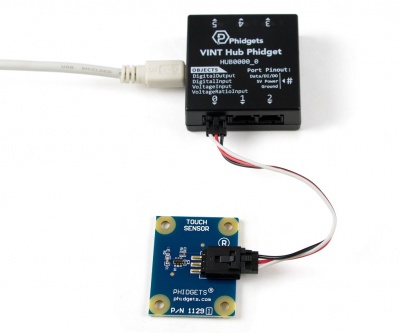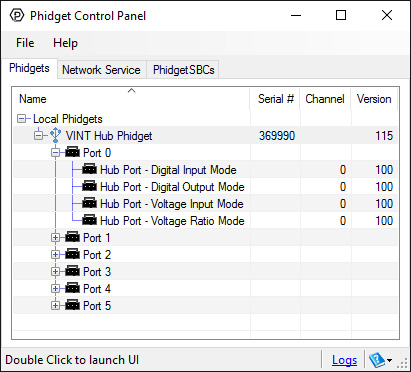
Note: The 1129_1B is identical to the 1129_1, except that you have the option of which size of Phidget cable to include.
The 1129 is a capacitive touch sensor and can detect a touch through plastic, glass, or paper. We recommend a material thickness of up to 1/2”.
The sensor can work as a close proximity sensor, sensing objects at a distance of up to 1/2” from the board in all directions without direct contact.
On the bottom side of the Touch Sensor there is a small exposed metallic pad. A soldered connection can be made to the pad to increase the size and dimensions of the touchable area, such as attaching the sensor to a metallic object or some wire.
The 1129_1B has a sensing chip that recalibrates after 45 seconds of contact (as opposed to 60 seconds on the 1129_0). Other than that, this sensor will function the same as the 1129_0. Please refer to the table below to see the differences:
| Feature | 1110 | 1129_0 | 1129_1 or 1129_1B |
|---|---|---|---|
| Sensitivity (Thickness of Material) | 1/8" | 1/2" | 1/2" |
| Sensor value (voltage) when Touching | 0 (0V) | 1000 (5V) | 1000 (5V) |
| Recalibration Timeout | N/A | 60s | 45s |
This sensor can be read by any Phidget with an Analog Input or VINT Hub port. It will connect to either one using a Phidget cable. VINT Hub ports can behave just like Analog Inputs, but have the added flexibility of being able to be used as digital inputs, digital outputs, or ports to communicate with VINT devices. For more information about VINT, see the VINT Overview page.
| Product | Voltage Inputs | ||
|---|---|---|---|
| Part Number | Price | Number of Voltage Inputs | Voltage Input Resolution (bits) |
 VINT Hub Phidget
|
$40.00 | 6 (Shared) | *** 15 bit |
 1-Port VINT Hub Phidget
|
$24.00 | 1 (Shared) | ** 16 bit |
 VINT Hub Phidget
|
$35.00 | 6 (Shared) | * 15 bit |
 VINT Hub Phidget
|
$30.00 | 6 (Shared) | *** 15 bit |
 Wireless VINT Hub
|
$60.00 | 6 (Shared) | * 16 bit |
 PhidgetSBC4
|
$120.00 | 6 (Shared) | * 16 bit |
 8x Voltage Input Phidget
|
$20.00 | 8 | 12 bit |
 PhidgetInterfaceKit 8/8/8
|
$80.00 | 8 | — |
 PhidgetInterfaceKit 2/2/2
|
$50.00 | 2 | 10 bit |
 PhidgetInterfaceKit 8/8/8
|
$80.00 | 8 | 10 bit |
 PhidgetInterfaceKit 8/8/8 Mini-Format
|
$70.00 | 8 | 10 bit |
 PhidgetInterfaceKit 8/8/8 w/6 Port Hub
|
$110.00 | 8 | 10 bit |
 PhidgetTextLCD 20X2 : White : Integrated PhidgetInterfaceKit 8/8/8
|
$70.00 | 8 | 10 bit |
This sensor requires a Phidget cable to connect it to an InterfaceKit or Hub. You can solder multiple cables together in order to make even longer Phidget cables, but you should be aware of the effects of having long wires in your system. See a full list of Phidget cables below.
| Product | Physical Properties | |
|---|---|---|
| Part Number | Price | Cable Length |
 Phidget Cable 10cm
|
$1.50 | 100 mm |
 Phidget Cable 30cm
|
$1.75 | 300 mm |
 Phidget Cable 60cm
|
$2.00 | 600 mm |
 Phidget Cable 90cm
|
$2.00 | 900 mm |
 Phidget Cable 120cm
|
$2.25 | 1.2 m |
 Phidget Cable 150cm
|
$2.50 | 1.5 m |
 Phidget Cable 180cm
|
$2.75 | 1.8 m |
 Phidget Cable 350cm
|
$3.00 | 3.5 m |
 Phidget Cable Kit
|
$10.00 | 80 mm |
Welcome to the 1129 user guide! In order to get started, make sure you have the following hardware on hand:
Next, you will need to connect the pieces:

Now that you have everything together, let's start using the 1129!
In order to demonstrate the functionality of the 1129, we will connect it to the HUB0000, and then run an example using the Phidget Control Panel on a Windows machine.
The Phidget Control Panel is available for use on both macOS and Windows machines. If you would like to follow along, first take a look at the getting started guide for your operating system:
Linux users can follow the getting started with Linux guide and continue reading here for more information about the 1129.
After plugging in the 1129 into the HUB0000, and the HUB0000 into your computer, open the Phidget Control Panel. You will see something like this:

The Phidget Control Panel will list all connected Phidgets and associated objects, as well as the following information:
The Phidget Control Panel can also be used to test your device. Double-clicking on an object will open an example.
Double-click on a Voltage Ratio Input object in order to run the example:

General information about the selected object will be displayed at the top of the window. You can also experiment with the following functionality:
The 1129 is actually a capacitive change sensor. When the capacitance changes the Sensor Value reports 1. If the Sensor Value remains at 1 for longer than 60 seconds, it will recalibrate back down to 0, regardless if the sensor is still being touched. This recalibration can also be done manually by unplugging and plugging the sensor back into the HUB0000 (or compatible product). This is a useful feature because it means that the sensor can be mounted on a flat surface such as a piece of glass or plastic and be reset so that it does not register the change in capacitance caused by the surface it is mounted on. On the bottom side of the 1129 there is a small exposed metallic pad. A soldered connection can be made to the pad to increase the size and dimensions of the touchable area, such as attaching the sensor to a metallic object or some wire. Once the sensor is recalibrated, the Sensor Value will increase to 1 if the attached object is touched anywhere. Although there is an exposed metallic pad on the bottom of the board, the pad does not have to be touched directly to activate the sensor - touching anywhere on the board will activate the sensor. The 1129 can work as a close proximity sensor, sensing objects at a distance of up to 1/2" from the board in all directions without direct contact. The 1129 will also work through a thickness of up to 1/2" of glass, plastic, or paper.

The Phidget Cable is a 3-pin, 0.100 inch pitch locking connector. Pictured here is a plug with the connections labelled. The connectors are commonly available - refer to the Analog Input Primer for manufacturer part numbers.
The capacitor labelled C1 is the sensing capacitor. In other words this is the capacitor that determines how sensitive the sensor is. By default it is a 10nF capacitor. By changing this value we can adjust the sensitivity. Smaller capacitors will yield lower sensitivity while higher values will yield higher sensitivity. The integrated circuit (IC) on the 1129 specifies that the acceptable range for C1 is 2nF-50nF. In testing, 2nF will not sense through any thickness of material while 50nF can sense through over 1" of material and even through double paned windows with an air gap of up to 3/4". If the size of your capacitive touch surface is very large, you may have to increase C1 even more. Up to 100nF even. (C1 is soldered onto the board, in order to replace it you will need a soldering iron).
The DST1200 will fire saturation error events when the nearest reflection is closer than 40mm from the sensor. At this range it is too close for the sensor to accurately determine the range of the object.
If this happens, it could be due to interference on the power supply. If you're using the 1129 on a Wireless VINT Hub, laptop, or PhidgetSBC, try switching out the power supply to see if the problem persists.
| Sensor Properties | |
|---|---|
| Sensor Type | Touch (Capacitive) |
| Controlled By | VoltageRatio Input |
| Sensor Output Type | Ratiometric |
| Detecting Distance Max | 12.7 mm |
| Electrical Properties | |
| Current Consumption Max | 500 μA |
| Output Impedance | 1 kΩ |
| Supply Voltage Min | 1.8 V DC |
| Supply Voltage Max | 5.5 V DC |
| Physical Properties | |
| Operating Temperature Min | -40 °C |
| Operating Temperature Max | 85 °C |
| Customs Information | |
| Canadian HS Export Code | 8473.30.00 |
| American HTS Import Code | 8473.30.51.00 |
| Country of Origin | CN (China) |
| Date | Board Revision | Device Version | Packaging Revision | Comment |
|---|---|---|---|---|
| November 2009 | 0 | N/A | Product Release | |
| September 2012 | 1 | N/A | Redesign due to component obsolescence | |
| December 2017 | 1 | N/A | B | Removed Phidget cable from packaging |
This device doesn't have an API of its own. It is controlled by opening a VoltageRatioInput channel on the Phidget that it's connected to. For a list of compatible Phidgets with VoltageRatio Inputs, see the Connection & Compatibility tab.
You can find details for the VoltageRatioInput API on the API tab for the Phidget that this sensor connects to.